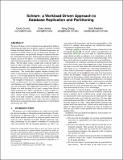| dc.contributor.author | Curino, Carlo | |
| dc.contributor.author | Jones, Evan Philip Charles | |
| dc.contributor.author | Zhang, Yang | |
| dc.contributor.author | Madden, Samuel R. | |
| dc.date.accessioned | 2012-09-27T15:23:55Z | |
| dc.date.available | 2012-09-27T15:23:55Z | |
| dc.date.issued | 2010-09 | |
| dc.identifier.issn | 2150-8097 | |
| dc.identifier.uri | http://hdl.handle.net/1721.1/73347 | |
| dc.description.abstract | We present Schism, a novel workload-aware approach for database partitioning and replication designed to improve scalability of shared-nothing distributed databases. Because distributed transactions are expensive in OLTP settings (a fact we demonstrate through a series of experiments), our partitioner attempts to minimize the number of distributed transactions, while producing balanced partitions. Schism consists of two phases: i) a workload-driven, graph-based replication/partitioning phase and ii) an explanation and validation phase. The first phase creates a graph with a node per tuple (or group of tuples) and edges between nodes accessed by the same transaction, and then uses a graph partitioner to split the graph into k balanced partitions that minimize the number of cross-partition transactions. The second phase exploits machine learning techniques to find a predicate-based explanation of the partitioning strategy (i.e., a set of range predicates that represent the same replication/partitioning scheme produced by the partitioner).
The strengths of Schism are: i) independence from the schema layout, ii) effectiveness on n-to-n relations, typical in social network databases, iii) a unified and fine-grained approach to replication and partitioning. We implemented and tested a prototype of Schism on a wide spectrum of test cases, ranging from classical OLTP workloads (e.g., TPC-C and TPC-E), to more complex scenarios derived from social network websites (e.g., Epinions.com), whose schema contains multiple n-to-n relationships, which are known to be hard to partition. Schism consistently outperforms simple partitioning schemes, and in some cases proves superior to the best known manual partitioning, reducing the cost of distributed transactions up to 30%. | en_US |
| dc.description.sponsorship | Quanta Computer (Firm) (T-Party Project) | en_US |
| dc.language.iso | en_US | |
| dc.publisher | Very Large Data Base Endowment Inc. (VLDB Endowment) | en_US |
| dc.relation.isversionof | http://dl.acm.org/citation.cfm?id=1920853 | en_US |
| dc.rights | Creative Commons Attribution-Noncommercial-Share Alike 3.0 | en_US |
| dc.rights.uri | http://creativecommons.org/licenses/by-nc-sa/3.0/ | en_US |
| dc.source | MIT web domain | en_US |
| dc.title | Schism: a Workload-Driven Approach to Database Replication and Partitioning | en_US |
| dc.type | Article | en_US |
| dc.identifier.citation | Carlo Curino, Evan Jones, Yang Zhang, and Sam Madden. 2010. Schism: a workload-driven approach to database replication and partitioning. Proc. VLDB Endow. 3, 1-2 (September 2010), 48-57. | en_US |
| dc.contributor.department | Massachusetts Institute of Technology. Computer Science and Artificial Intelligence Laboratory | en_US |
| dc.contributor.department | Massachusetts Institute of Technology. Department of Electrical Engineering and Computer Science | en_US |
| dc.contributor.mitauthor | Curino, Carlo | |
| dc.contributor.mitauthor | Jones, Evan Philip Charles | |
| dc.contributor.mitauthor | Zhang, Yang | |
| dc.contributor.mitauthor | Madden, Samuel R. | |
| dc.relation.journal | Proceedings of the VLDB Endowment | en_US |
| dc.eprint.version | Author's final manuscript | en_US |
| dc.type.uri | http://purl.org/eprint/type/ConferencePaper | en_US |
| dc.identifier.orcid | https://orcid.org/0000-0002-7470-3265 | |
| mit.license | OPEN_ACCESS_POLICY | en_US |
| mit.metadata.status | Complete | |
